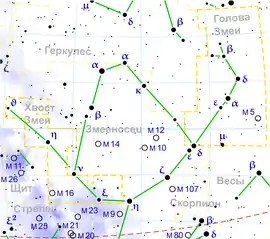Coordenaes: ![]() 18h 21m 18.601s, -2° 53′ 55.777″
18h 21m 18.601s, -2° 53′ 55.777″
Eta Serpentis (η Ser / 58 Serpentis / HD 168723)[11] ye una estrella na constelación de Serpens de magnitú aparente +3,26. Asitiada en Serpens Cauda —la cola de la culiebra—, ye la segunda estrella más brillosa del conxuntu de la constelación, namái superada por Unukalhai (α Serpentis). Magar nun tien nome propiu habitual, dacuando recibe'l nome de Tang, del mandarín 唐朝 "Táng Cháo", pola dinastía imperial Tang.
Asitiada a 60,5 años lluz del Sistema Solar, Eta Serpentis ye una xigante naranxa o subxigante de tipu espectral K0III-IV,[11] con una temperatura efectivo de 4871 K.[12] La so lluminosidá bolométrica —en toles llonxitúes d'onda— ye 19 vegaes mayor que la lluminosidá solar y la midida del so diámetru angular considerando'l escurecimientu de llimbu, 2,98 milisegundos d'arcu,[13] dexa evaluar el so diámetru real, cuasi seis veces más grande que'l del Sol.
Eta Serpentis tien un conteníu metálico inferior al del Sol, con un valor entendíu ente'l 66%[14] y el 72%[12] del mesmu —la cifra exauta varia según autores. Xira amodo sobre sigo mesma, con una velocidá de rotación proyeutada de 2,0 ± 0,5 km/s.[15] La so masa envalorada ye de 1,84 mases solares[14] y puede tener una edá d'aproximao 2800 millones d'años. Hai unos 150 millones d'años terminó la fusión del so hidróxenu internu y probablemente tea aumentando en rellumu con un nucleu inerte d'heliu; cuando nun futuru convertir nuna xigante colorada, va ser 25 vegaes más lluminosa que na actualidá.[16]
Referencies
- 1 2 3 4 5 6 7 Afirmao en: SIMBAD.
- 1 2 Floor van Leeuwen (2007). «Validation of the new Hipparcos reduction» (n'inglés). Astronomy and Astrophysics (2): páxs. 653–664. doi:.
- ↑ Caroline Soubiran (marzu 2008). «Vertical distribution of Galactic disk stars» (n'inglés). Astronomy and Astrophysics (1): páxs. 91–101. doi:.
- ↑ «Abundances in the Local Region II: F, G, and K Dwarfs and Subgiants». The Astronomical Journal (1). 21 avientu 2016. doi:.
- ↑ Caroline Soubiran (agostu 2018). «Gaia Data Release 2. The catalogue of radial velocity standard stars» (n'inglés). Astronomy and Astrophysics: páxs. 7–7. doi:.
- ↑ Afirmao en: Gaia DR2. Stated in source according to: SIMBAD. Llingua de la obra o nome: inglés. Data d'espublización: 25 abril 2018.
- ↑ URL de la referencia: https://dx.doi.org/10.1051%2F0004-6361%2F200912103.
- ↑ J. Maldonado (xunu 2013). «The metallicity signature of evolved stars with planets» (n'inglés). Astronomy and Astrophysics: páxs. 84–84. doi:.
- ↑ Henrik Jönsson (8 febreru 2017). «Abundances of disk and bulge giants from high-resolution optical spectra. I. O, Mg, Ca, and Ti in the solar neighborhood and Kepler field samples» (n'inglés). Astronomy and Astrophysics. doi:.
- ↑ «The Perkins catalog of revised MK types for the cooler stars» (n'inglés). The Astrophysical Journal Supplement Series: páxs. 245–266. ochobre 1989. doi:.
- 1 2 Eta Serpentis (SIMBAD)
- 1 2 Soubiran, C.; Bienaymé, O.; Mishenina, T. V.; Kovtyukh, V. V. (2008). «Vertical distribution of Galactic disk stars. IV. AMR and AVR from clump giants». Astronomy and Astrophysics 480 (1). páxs. 91-101. http://cdsads.u-strasbg.fr/cgi-bin/nph-bib_query?2008A%26A...480...91S&db_key=AST&nosetcookie=1.
- ↑ Richichi, A.; Percheron, I.; Khristoforova, M. (2005). «CHARM2: An updated Catalog of High Angular Resolution Measurements». Astronomy and Astrophysics 431 (4). páxs. 773-777. http://cdsads.u-strasbg.fr/cgi-bin/nph-bib_query?2005A%26A...431..773R&db_key=AST&nosetcookie=1.
- 1 2 Takeda, Y.; Sato, B.; Murata, D. (2008). «Stellar Parameters and Elemental Abundances of Late-G Giants». Publications of the Astronomical Society of Japan 60 (4). páxs. 781 - 802. http://cdsads.u-strasbg.fr/cgi-bin/nph-bib_query?2008PASJ...60..781T&db_key=AST&nosetcookie=1.
- ↑ Carney, Bruce W.; Gray, David F.; Yong, David; Latham, David W.; Manset, Nadine; Zelman, Rachel; Laird, John B. (2008). «Rotation and Macroturbulence in Metal-Poor Field Rede Giant and Rede Horizontal Branch Stars». The Astronomical Journal 135 (3). páxs. 892-906. http://cdsads.u-strasbg.fr/cgi-bin/nph-bib_query?2008AJ....135..892C&db_key=AST&nosetcookie=1.
- ↑ Eta Serpentis (Stars, Jim Kaler)
